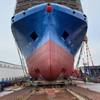Chief of Naval Operations (CNO) Adm. Mike Mullen talks with Government Executive Magazine Editor Tim Clark, during a leadership breakfast at the National Press Club. The CNO addressed senior leaders from several federal agencies and organizations about the future and transformation of the Navy. U.S. Navy photo by Chief Photographer's Mate Johnny Bivera
The Navy’s shipbuilding plan is the key to the fleet’s future and is critical for the joint force, Chief of Naval Operations Adm. Mike Mullen told an audience at a Leadership Breakfast sponsored by Government Executive Magazine at the National Press Club here April 24.
Mullen took the opportunity to reiterate the strength of his shipbuilding plan, submitted Feb. 7 with the Navy's FY-07 budget proposal. The plan calls for a fleet of about 313 ships. He said that today's current fleet of 281 ships, while very capable, is as low as the Navy can go without damaging its ability to meet warfighting requirements.
“I don’t believe that for the nation, that we can take care of what it requires of the United States Navy if we get any smaller,” Mullen said. “That said, we need a certain number. What I want to do is build fleets. We have a tendency to focus on individual ships and individual programs. I need to be building fleets and capabilities within those fleets.”
The plan requires $13.4 billion in shipbuilding funds each year, and among the biggest challenges: the fiscal discipline required to protect those funds once appropriated.
“The key is being able to fund that whole fund, which I’m going to have to be able to do. And we’ve got a bad habit in this town, and particularly inside the Navy, where the pot of shipbuilding money is so big that you can buy a lot of things with it. So people continuously reach in, and we figure out how we’re going to do shipbuilding after everything else,” Mullen said.
“We’re going to figure out how we’re going to do shipbuilding first, and then we’re going to figure out how we’re going to do everything else,” he asserted.
In addition, Mullen said he doesn’t expect any significant increase in the Navy’s overall budget to come from Congress. Navy leaders and industry are going to have to work together more closely than ever before to properly allocate resources and control costs.
“The budget climate’s always tough, and it’s particularly challenging now,” stressed Mullen. "That’s what I’m talking about with my leadership, is to set expectations that we’re going to have to build the Navy of the future from within the resources we have. And that’s why this effort on productivity and controlling costs is so important,” Mullen said.
He said he’s put mechanisms in place even among his own staff to attack rising costs, especially in three areas he calls “C2T”: complexity, concurrency, and time – all elements that factor into the production of a platform and keeping the process on schedule.
“The areas that I really want to pay attention to are the complexity of the ships, the concurrency of the programs, and then schedule. I don’t think there’s anything that costs me more money than scheduling,” he said.
Mullen stressed the great potential of focusing on a new ship's lifecycle costs rather than on just the immediate costs of putting it to sea. These costs include maintenance, refueling and manning, from keel-laying to decommissioning, and are areas where seemingly expensive high-tech investments made up front are recouped in the long run.
From Chief of Naval Operations Public Affairs
Subscribe for
Maritime Reporter E-News
Maritime Reporter E-News is the maritime industry's largest circulation and most authoritative ENews Service, delivered to your Email five times per week










